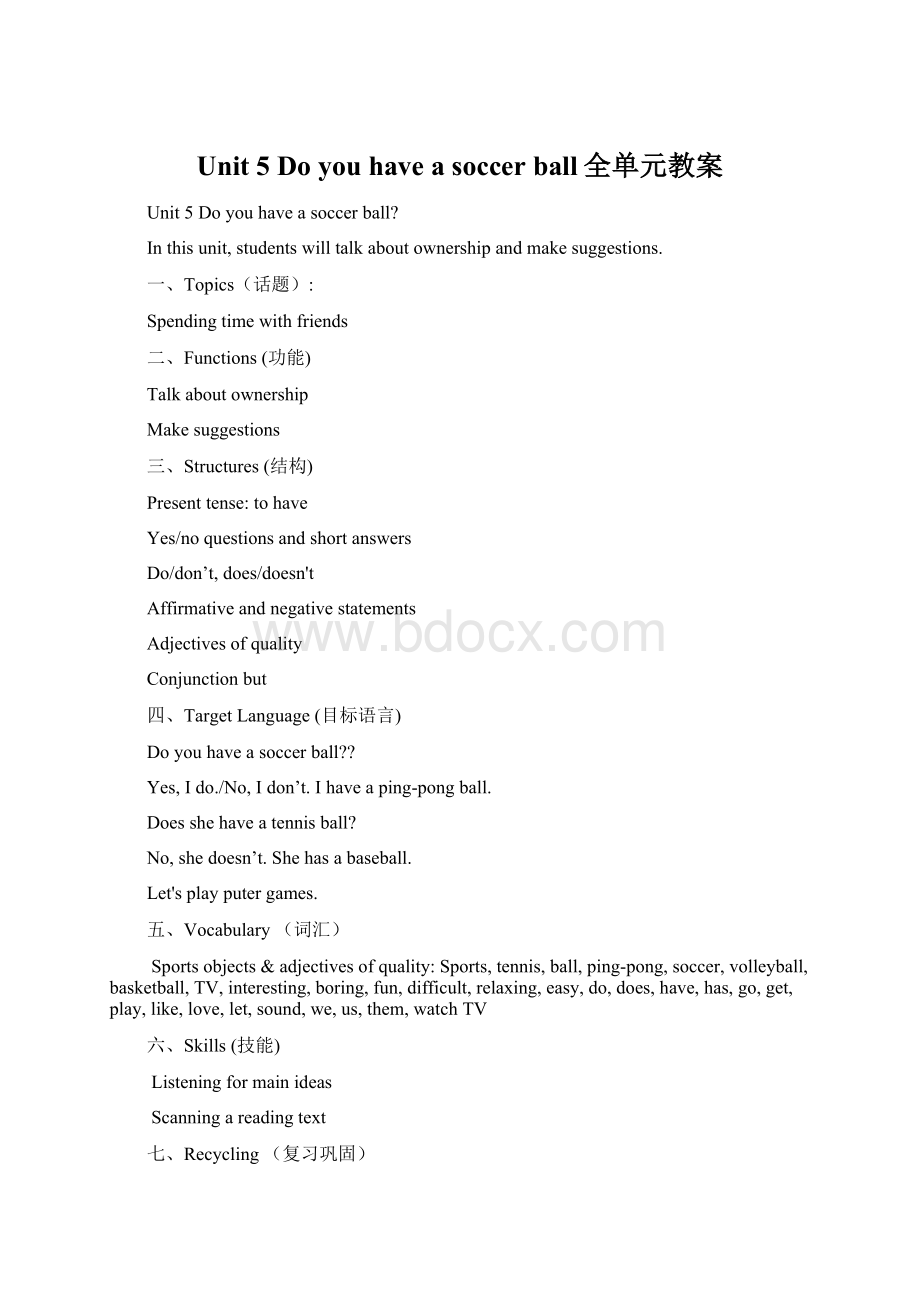Unit 5 Do you have a soccer ball全单元教案.docx
《Unit 5 Do you have a soccer ball全单元教案.docx》由会员分享,可在线阅读,更多相关《Unit 5 Do you have a soccer ball全单元教案.docx(17页珍藏版)》请在冰豆网上搜索。

Unit5Doyouhaveasoccerball全单元教案
Unit5Doyouhaveasoccerball?
Inthisunit,studentswilltalkaboutownershipandmakesuggestions.
一、Topics(话题):
Spendingtimewithfriends
二、Functions(功能)
Talkaboutownership
Makesuggestions
三、Structures(结构)
Presenttense:
tohave
Yes/noquestionsandshortanswers
Do/don’t,does/doesn't
Affirmativeandnegativestatements
Adjectivesofquality
Conjunctionbut
四、TargetLanguage(目标语言)
Doyouhaveasoccerball?
?
Yes,Ido./No,Idon’t.Ihaveaping-pongball.
Doesshehaveatennisball?
No,shedoesn’t.Shehasabaseball.
Let'splayputergames.
五、Vocabulary(词汇)
Sportsobjects&adjectivesofquality:
Sports,tennis,ball,ping-pong,soccer,volleyball,basketball,TV,interesting,boring,fun,difficult,relaxing,easy,do,does,have,has,go,get,play,like,love,let,sound,we,us,them,watchTV
六、Skills(技能)
Listeningformainideas
Scanningareadingtext
七、Recycling(复习巩固)
Where’s?
It’s...
八、教材分析
本单元主要学习动词have的一般现在时的用法;使用do和does引导的一般疑问句的构成以及简单回答。
本单元围绕“和朋友一起欢度时光”这一话题安排了三个任务:
一是列举所学的运动项目,从中挑选出各自喜欢的体育项目,并说明原因,目的是巩固并新学一些体育项目的名词;二是让学生互相询问所爱好的运动,并根据情况发出邀请,学会用have对物品的所属进行提问与回答,掌握用do和does引导的一般疑问句的构成及使用,了解用Let’s提建议的句型;三是写作,把任务一、二的完成情况写成日记,进一步复习、巩固所学的语言目标。
SectionA
1a,1b,1c重点学习表示运动及游戏名称的词。
2a,2b,2c继续学习表示运动的名词并学习谈论物主关系。
3a,3b,3c学习“提出建议”的功能句式。
SectionB
1a,1b,1c,1d,2a,2b,2c重点学习描述活动状况的形容词。
3a,3b,3c阅读介绍体育用品或其它物品的短文,学会写介绍体育用品的小短文。
SelfCheck复习并扩充表示体育用品、描述活动状况的词汇及表示提出建议的句型。
九、学情分析
本单元的主题是使用have对物品的所属进行提问及回答,以掌握行为动词在一般现在时中的构成和使用;同时引导学生使用所学的句型谈论自己在球类运动中的喜好。
行为动词在一般现在时的肯定句、否定句和一般疑问句中的构成和使用是初中英语教学中非常重要的内容,本单元知识的掌握程度将直接影响今后的英语学习。
学生在以前的学习中已经掌握了be动词在一般现在时中的构成和使用,在学生的头脑中也已经形成了一个模式,这种模式将直接影响学生对本单元知识内容的接受,所以教师在教学中一定要善于引导,以免学生养成不良习惯。
十、课时安排
Thefirstperiod(第一课时):
SectionA(1a–2d)
Thesecondperiod(第二课时):
SectionA(Grammarfocus–3c)
Thethirdperiod(第三课时):
SectionB(1a–1d)
Thefourthperiod(第四课时):
SectionB(2a–2c)
Thefifthperiod(第五课时):
SectionB(3aSelfCheck)
TheFirstPeriod(SectionA,1a–2d)
Teachingaims(教学目标)
1.学会用have对物品的所属进行提问以及应答;
2.学会使用do和does引导的一般疑问句;
3.学会用Let’s…提建议;
4.能够谈论自己喜欢哪些球类运动,不喜欢哪些球类运动。
Languagepoints(语言点)
1.掌握以下重点句型:
Doyou/theyhave…?
Doeshe/shehave…?
Let’splaysoccer.
Doyou/theyhaveaTV?
Yes,I/theydo.No,I/theydon’t.
Doeshe/shehaveasoccerball?
Yes,he/shedoes.No,he/shedoesn’t.
2.要求掌握以下词汇:
一些球类运动器材名词tennis,bat,volley,basketball,television,interesting,boring,fun,difficult,relaxing,wele,our,sports,center,like,we,many,club,ping-pong,more,join,class
Difficulties(难点):
行为动词have的一般现在时的用法;使用do和does引导的一般疑问句的构成和使用。
Teachingsteps(教学步骤)
Leadin:
T:
Goodmorning,everyone!
Lastweek,wefinishedUnit4.Todaywearegoingtostartanewunit,Unit5.
Askandanswer
a.T:
CanyoutellmewhatthetitleofUnit5is?
Yes,it’s“Doyouhaveasoccerball?
”Whatdoyouthinktheunitisabout?
b.T:
Great!
Inthisunit,wearegoingtolearntotalkaboutownershipandsomesportswords.“Ownership”means“物品的所有者”.
Step1:
SectionA1a
T:
First,pleaseopenyourbookstopage25andlookatactivity1a.
1.Lookandfind
T:
Pleaselookatthepictureinactivity1a.Therearesomeballsinit.Doyouknowwhatkindofballstheyare?
2.Matchanddiscuss
a.T:
Wouldyoupleasematchthewordswiththethingsinthepicture?
b.T:
Howmanywordsdoyouknow?
Canyousharethewordsyouknowwithyourpartners?
c.T:
Pleasediscusswithyourpartnersandcheckwhetheryouranswersarethesame.
3.Checktheanswers
T:
Let’schecktheanswerstogether.
Answers:
2.f3.c4.e5.d6.b
4.Read
a.T:
Pleasereadthewordsafterme.Tennisball...
b.T:
Iwouldlikeyoutoreadthewordstogetherandreadeachwordtwice.Tennisracket,tenniracket...
c.Whowouldliketoreadthewordstotheclass?
d.Let’sreadthewordsonebyoneagaintogether.
【教学设计说明】
采用Discussionandguess和Classifying的学习策略,利用实物、教学幻灯片、图片等来展开课堂Pairwork问答式的口语交际活动,使用have对物品的所属进行提问及回答。
Step2:
SectionA1b
1.Listenandcircle
a.T:
Listentotherecordingforthefirsttime.
b.T:
Circlethewordswhenyoulistentoitforthesecondtime.
2.Checktheanswers
T:
Let’schecktheanswers.
Answers:
circleditems:
ping-pongbat,ping-pongball
3.Read
a.T:
Iwouldlikeyoutoreadthetapescripttogether.
b.T:
Wouldyoupleasereaditbyyourselvesthreetimes?
c.T:
ThistimeIwouldlikeyoutoreadittwicewithyourpartners.
d.T:
Whowouldliketoreadittotheclass?
4.Translateandexplain
a.T:
WhowouldliketotelluswhattheconversationmeansinChinese?
b.T:
Whenwewanttoknowifsomeonehassomething,weusethesentence:
“Doyouhave...?
”
【教学设计说明】
听lb部分的录音,圈出所听到的单词,并画出相应的图片,完成1b部分的学习任务。
教师平时收集课文中所涉及的或学生常见的球类运动器材或有关的教学幻灯片或图片;设计课后巩固练习的幻灯片;制作1a部分的插图和人物对话的课件,将听力部分的内容插人,通过询问对方的所属以及回答来引入新课。
Step3:
SectionA1c
1.Read
T:
Wouldyouliketoreadtheconversationwithyourpartners?
2.Practice
a.T:
Wouldyoupleasepracticetheconversationaccordingtothepicturein1a?
b.T:
Pleasepresentyourconversationstotheclass.Whowouldliketohaveatry?
【教学设计说明】
Pairwork活动,完成lc部分口语交际的学习任务,学会运用助动词do进行问答。
学生搜集自己所了解的或曾经见过的球类运动器材的名称,并通过询问老师、同学或上网查询的方式了解各种运动的竞赛方法。
Step4:
SectionA2a
1.Look
T:
Let’smovetoactivity2anow.
2.Listenandnumber
a.T:
Now,let’slistentotherecordingforthefirsttime.
b.T:
Areyoureadytodoactivity2a?
c.T:
Pleasenumberthepicturesfrom1to4asyoulisten.
d.T:
Listenagainandpleasecheckyouranswers.
2.Checktheanswers
T:
Doyouhavetheanswers?
Let’scheckthemtogether.
Answers:
3,1,4,2
【教学设计说明】
听2a部分的录音,选出他们所听到的对话并标明顺序,完成2a部分的学习任务。
该部分学习内容贴近学生的生活,谈论的主题是符合学生喜爱运动的心理,极易于激发学生学习英语的欲望和兴趣,使他们乐于参与各种英语实践活动。
Step5:
SectionA2b
1.Listenandmatch
a.T:
Listentotherecordingagain.
b.T:
Matchthepeopleinactivity2awiththeballs.
2.Checktheanswers
T:
Finished?
Let’schecktheanswers.
Answers:
3,2,1,4
3.Readtheconversation
a.T:
Let’sreadtheconversationstogether.
b.T:
Iwouldlikeyoutoreadtheminpairs.
c.T:
Whowouldliketoreadthemfortheclass?
【教学设计说明】
重听2a部分的录音,将对话中所提到的球类和人物对应起来,并标明顺序,完成2b部分中的听力训练任务。
Step6:
SectionA2c
1.Lookandsay
T:
Let’smovetotheactivity2c.Pleaselookatthepicturesinactivities2aand2bandtalkaboutwhohaswhichballswithyourpartners.
2.Task-Ihave...
a.T:
Now,let’sdoatask-Ihave...Pleasemakeachartlikethisandwritedownsomethingsinthechartandaskyourfriendswhethertheyhavethem.
Things
Names
Numbersofstudents
hat
Mary,John
2
baseball
…
baseballbat
basketball
books
….
Example:
A:
Doyouhaveahat,Mary?
B:
Yes,Ido.
A:
Doyouhaveabaseball,Bob?
C:
No,Idon’t.....
b.T:
Ibelievemostofyouhavefinishedyoursurvey.Pleasegiveusareport.Iwouldliketogiveyouanexample.
Example:
Ididasurveyaboutthethingsmyfriendshave.Twostudentshavehats.Bobhasabasketball...
【教学设计说明】
Pairwork活动,完成2c部分口语交际的学习任务。
根据图画内容运用动词have进行询问所属,以练习由助动词do/does引导的一般疑问句结构。
Step7:
SectionA2d
T:
Role-playtheconversation.分角色表演对话。
【教学设计说明】
教师让每个学生在白纸上画一幅画,画的内容是反映一个人在做运动或某个活动,并在画中画出电脑、网球拍或篮球等物体;然后收集图画,出示给学生看,使用Doeshe/shehave…?
句型向学生提问,让学生回答;把图画放在讲台上,再选派一些学生上台就图画内容向学生询问(可不把图画给学生看),让学生猜出答案。
这种活动可练习have一般疑问句的构成和回答,又能调动学生的学习兴趣,十分有效。
Step8:
Summarize
T:
Let’ssummarizewhatwelearnedinthisperiod.
Step9:
Homework
1.Copythewordsinactivity1aandthesentencesingrammarbox.
2.Readthetapescriptofactivities2aand2b.
TheSecondPeriod(SectionA,Grammarfocus–3c)
Teachingaims(教学目标)
1.学会用have对物品的所属进行提问以及应答;
2.学会使用do和does引导的一般疑问句;
Languagepoints(语言点)
2.掌握以下重点句型:
Doyou/theyhaveaTV?
Yes,I/theydo.No,I/theydon’t.
Doeshe/shehaveasoccerball?
Yes,he/shedoes.No,he/shedoesn’t.
2.要求掌握以下词汇:
一些球类运动器材名词tennis,bat,volleyball,basketball,television,interesting,boring,fun,difficult,relaxing
Difficulties(难点):
行为动词have的一般现在时的用法;使用do和does引导的一般疑问句的构成和使用。
Teachingsteps(教学步骤)
Leadin:
T:
Whatdidwelearnyesterday?
Whocantellus?
Yes.YesterdaywegottoknowhowtotalkaboutownershipandwealsolearnedsomesportswordsinEnglish.Doyoustillrememberthem?
OK,let’sreviewthemfirst.
Step1:
Revision
1.Askandanswer
a.T:
WouldyoupleasetranslatemywordsintoEnglish?
网球、足球……
b.T:
WhowouldliketomakeconversationsusingthepicturesinthePPT?
2.Dictation
T:
Pleasetakeoutyourdictationexercisebooksandlet’shaveadictation.
Step2:
GrammarFocus
1.Read
T:
Readtheconversationsinthegrammarbox.
2.Pointoutthenotes
助动词do的用法;
助动词does的用法;
助动词do和does引导的一般疑问句及其回答。
【教学设计说明】
动词的第三人称单数形式:
当句子的主语是“第三人称单数”时,即:
不是I,不是you的其它单数形式时,谓语动词必须改变形式,也就是在词尾加-s或-es(同名词的复数形式),我们可以简称为“三单形式”。
有些动词的变化是特殊的,如:
have的三单形式是has。
在构成否定句时。
要在动词前加助动词don’t或doesn’t;在构成疑问句时,则要在主语前加上助动词do或does,does/doesn’t是do/don’t的三单形式。
助动词后应该用动词的原形。
SectionA3a
1.Writeeachwordinthecorrectplaceinthechart.
T:
Let’sgotoactivity3aonpage27.
do
does
I,they,you,we
he,she,it,Eric
2.Checktheanswers
T:
Haveyoufinished?
Pleasecheckyouranswerswithyourpartners.
3.TranslateintoChinese
a.T:
WouldyoupleasetranslatethewordsintoChinesewithyourpartners?
b.WhowouldliketotranslatethemintoChineseforus?
4.Read
a.T:
Let’sreadthewordstogether.
b.T:
Whowouldliketoreadthemtotheclass?
【教学设计说明】将方框中的单词填入表格的正确位置。
Step3:
SectionA3b
1.Fillintheblankswithdoordoes.Thenpracticetheconversationswithyourpartner.
a.T:
Let’smovetoactivity3b.
b.T:
Pleaselookattheconversationsandreadthemtogether.
c.T:
Iwouldlikeyoutoreadtheminpairs.
d.T:
Whowouldliketoreadthemtotheclass?
Iwillinvitesomepairstoreadthemtotheclass.
2.Pairwork
a.